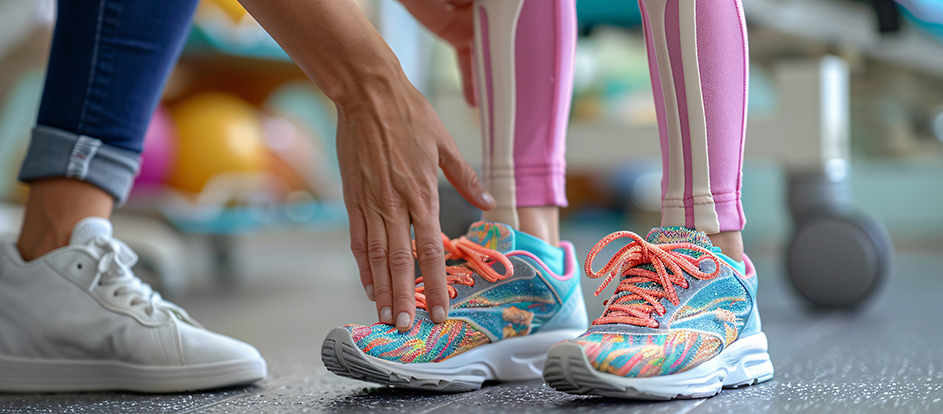

Footwear And Foot Health: A Physiotherapist’s Guide to Supporting Your Child’s Posture

Latisha Lewis
DHA License Number: 11845996-003
Senior Physical Therapist

As a paediatric physiotherapist, one of the most common questions received from parents is: “What shoes are best for my child?” The answer isn’t just about comfort or style, it’s about supporting your child’s developing posture, balance, and overall physical health. Choosing the right footwear at the right stage can help prevent long-term issues with gait, alignment, and even back pain.
A child’s foot is not simply a smaller version of an adult foot; it’s a developing structure. At birth, babies have soft, flexible feet with a fat pad where the arch will eventually form. As they grow and begin to walk, the foot gradually strengthens, bones ossify, and the arch develops naturally through movement and load-bearing. Most children don’t have a fully formed arch until around six to eight years of age. The shape of the foot, as well as coordination and strength, continues evolving throughout childhood.

Because feet grow so rapidly, it’s important that footwear evolves along with these developmental stages – not just in size, but in support, flexibility, and structure. In the early years, footwear should be lightweight, flexible, and feature a wide toe box to accommodate the natural growth of the developing foot. During the toddler years, and with the transition into increased mobility, shoes should begin to provide more structural support – specifically, a firm heel for rearfoot stability and mild arch support to guide developing foot posture without overcorrecting. For older, more active children, particularly those participating in sports or high-impact activities, footwear should prioritise shock absorption, breathability, and durable materials to reduce load on growing joints and minimise fatigue. At each stage of development, footwear should be reviewed regularly to maintain a balance between flexibility and protection for the evolving needs of the musculoskeletal system.

When footwear doesn’t support the foot’s natural biomechanics, the effects can ripple far beyond the feet themselves. Children’s bodies are highly responsive to external forces, and shoes that lack proper structure – such as those that allow excessive foot rolling or don’t stabilise the heel – can have a significant impact. Over time, this misalignment can contribute to compensatory movement patterns, leading to strain on the child’s joints. Research highlights that a lack of foot support during critical growth periods may alter the development of spinal posture and balance strategies. This means that a poorly constructed shoe doesn’t just affect how a child walks – it can influence how they stand, move, and maintain posture throughout the day. Footwear that respects natural movement while offering targeted support helps to optimise joint loading and postural stability as the child grows.
Beyond structural alignment, footwear plays a crucial role in sensory and motor development. Children’s feet are rich in nerve endings that provide vital feedback to the brain for balance, coordination, and spatial awareness. When shoes are too rigid or poorly designed, they can limit this input – reducing a child’s ability to adapt to different surfaces and maintain stability. Over time, this sensory disruption may lead to an over-reliance on certain muscles or to poor postural control. Conversely, footwear that offers appropriate flexibility and fit can enhance proprioception and support natural gait development as a child grows.
Key Footwear Features Parents Should Look For
When choosing shoes, look beyond the brand name or the cartoon character on the side. Instead, focus on these essential features:
- Partially flexible soles: The sole should bend at the toes, not in the middle of the foot.
- Wide toe box: Toes should have room to spread and grip.
- Secure closure: Laces, Velcro, or straps that hold the foot securely in place.
- Lightweight materials: Avoid overly heavy or rigid shoes.
- Firm heel counter: Offers rearfoot stability without over-restricting movement.
- Flat or low heel drop: Mimics barefoot posture and promotes better alignment.
- Breathable fabric: Helps prevent overheating and skin irritation.
- Style: High-top trainers with ankle support are recommended for children with marked flat feet or increased ankle mobility.
Physiotherapists play a key role in identifying and addressing early signs of postural or gait concerns. If your child walks on their toes, has flat feet, complains of leg pain, or seems clumsy, a paediatric physiotherapist can assess their movement patterns and offer tailored advice. This may include exercises to strengthen foot muscles, balance training, or recommendations for orthotics or specialist footwear.
We also educate parents on the value of barefoot play where it is safe and appropriate. Emerging evidence supports the role of barefoot time in promoting healthy foot development and enhancing spatial awareness. Walking on varied surfaces such as grass, carpet, or sand stimulates the proprioceptive receptors in the feet, increasing sensory input and encouraging neuromuscular engagement. These experiences help children develop better coordination and postural control. Barefoot activity can also have a grounding effect, supporting emotional regulation and reducing stress. However, it’s important to note that barefoot play may not be suitable for all children – those with conditions such as hypermobility or underdeveloped arches may require additional support to maintain comfort and prevent injury.
In summary, the right footwear does more than complete an outfit – it supports healthy development from the ground up. As a parent, you can help your child build strong foundations by choosing shoes that respect their natural movement and growth patterns. And if you’re ever unsure, your physiotherapist is here to guide you through each step of your child’s journey.
Practical Checklist for Parents
Before buying your child’s next pair of shoes, use this quick checklist:
- Is the shoe flexible at the toes?
- Can your child’s toes move freely inside?
- Does the shoe stay on securely with movement?
- Is there about a thumb’s width between the big toe and the end of the shoe?
- Is the shoe appropriate for your child’s daily activities (e.g., running, climbing)?
- Has your child outgrown their current shoes? (Check every 2–4 months.)
- Do the soles and heels show even wear?
Sources:
- Cranage, S., Perraton, L., Bowles, K. A., & Williams, C. (2020). The impact of shoe flexibility on gait, pressure and muscle activity of young children: A systematic review. Journal of Foot and Ankle Research, 13(4). https://doi.org/10.1186/s13047 019 0368 4 Wikipedia+8PubMed+8OUCI+8
- D’Août, K., Elnaggar, O., Mason, L., Rowlatt, A., & Willems, C. (2025). Footwear choice and locomotor health throughout the life course: A critical review. Healthcare, 13(5), 527. https://doi.org/10.3390/healthcare13050527
- Morrison, S. C., Price, C., McClymont, J., & Nester, C. (2018). Big issues for small feet: developmental, biomechanical and clinical narratives on children’s footwear. Journal of Foot and Ankle Research, 11, Article 39. https://doi.org/10.1186/s13047 018 0281 2
- Mickle, K. J., Munro, B. J., & Steele, J. R. (2011). Footwear affects the walking patterns of children with and without developmental coordination disorder. Journal of Foot and Ankle Research, 4(1), 1–7. https://doi.org/10.1186/1757-1146-4-24
- Riley, P. O. et al. (2021). Foot posture development in children aged 5 to 11 years: A three year prospective study. Gait & Posture, 68, 123 129. https://doi.org/. (Note: PubMed summary, full article DOI may need lookup.)
- Smith, A. et al. (2021). Children’s school footwear: The impact of fit on foot function, comfort and jump performance in children aged 8 to 12 years. Journal of Biomechanics, 53, 45 54. https://doi.org/.PMC (Note: PubMed summary placeholder.)
- Wegener, C. et al. (2013). Power generation of the midfoot in children wearing sports shoes. Journal of Foot and Ankle Research, 6, O35. https://doi.org/.
- Staheli, L. T. (1992). The influence of footwear on the prevalence of flat foot: A survey of 2300 children. Journal of Bone and Joint Surgery (British Volume), 74 B(4), 525 528. https://doi.org/.
- Various Authors. (2025). Understanding the Role of Children’s Footwear on Children’s Feet and Gait Development: A Systematic Scoping Review. [Journal]. Advance online publication. https://doi.org/.
- Uden, H., & Scharfbillig, R. (2017). The effect of footwear on children’s feet: A systematic review. Journal of Foot and Ankle Research, 10(1), 1–10. https://doi.org/10.1186/s13047-017-0214-1


